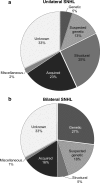The etiological evaluation of sensorineural hearing loss in children
- PMID: 31152317
- PMCID: PMC6647487
- DOI: 10.1007/s00431-019-03379-8
The etiological evaluation of sensorineural hearing loss in children
Abstract
This study aims to evaluate the etiology of pediatric sensorineural hearing loss (SNHL). A total of 423 children with SNHL were evaluated, with the focus on the determination of causative genetic and acquired etiologies of uni- and bilateral SNHL in relation to age at diagnosis and severity of the hearing loss. We found that a stepwise diagnostic approach comprising of imaging, genetic, and/or pediatric evaluation identified a cause for SNHL in 67% of the children. The most common causative finding in children with bilateral SNHL was causative gene variants (26%), and in children with unilateral SNHL, a structural anomaly of the temporal bone (27%). The probability of finding an etiologic diagnosis is significantly higher in children under the age of 1 year and children with profound SNHL.Conclusions: With our stepwise diagnostic approach, we found a diagnostic yield of 67%. Bilateral SNHL often has a genetic cause, whereas in unilateral SNHL structural abnormalities of the labyrinth are the dominant etiologic factor. The diagnostic yield is associated with the age at detection and severity of hearing loss: the highest proportion of causative abnormalities is found in children with a young age at detection or a profound hearing loss. What is Known: • Congenital sensorineural hearing loss is one of the most common congenital disorders • Determination of the cause is important for adequate management and prognosis and may include radiology, serology, and DNA analysis What is New: • Using a stepwise diagnostic approach, causative abnormalities are found in 67% both in uni- and bilateral SNHL, with the highest diagnostic yield in very young children and those suffering from profound hearing loss • Bilateral SNHL often has a genetic cause, whereas in unilateral SNHL structural abnormalities of the labyrinth are the dominant etiologic factor.
Keywords: Bilateral hearing loss; Children; Etiology; SNHL; Unilateral hearing loss.
Conflict of interest statement
The authors declare that they have no conflict of interest.
Figures



Similar articles
-
Evaluation of the outcome of CT and MR imaging in pediatric patients with bilateral sensorineural hearing loss.Int J Pediatr Otorhinolaryngol. 2018 May;108:180-185. doi: 10.1016/j.ijporl.2018.02.022. Epub 2018 Feb 15. Int J Pediatr Otorhinolaryngol. 2018. PMID: 29605351
-
Unilateral cochlear nerve deficiency in children.Otolaryngol Head Neck Surg. 2013 Aug;149(2):318-25. doi: 10.1177/0194599813487681. Epub 2013 May 15. Otolaryngol Head Neck Surg. 2013. PMID: 23678279
-
Cytomegalovirus DNA detection in Guthrie cards: role in the diagnostic work-up of childhood hearing loss.Otol Neurotol. 2009 Oct;30(7):943-9. doi: 10.1097/MAO.0b013e3181b76b22. Otol Neurotol. 2009. PMID: 19730140
-
Prognostic indicators for sensorineural hearing loss in temporal bone histiocytosis.Int J Pediatr Otorhinolaryngol. 2009 Dec;73(12):1616-20. doi: 10.1016/j.ijporl.2009.07.010. Epub 2009 Aug 9. Int J Pediatr Otorhinolaryngol. 2009. PMID: 19671478 Review.
-
Ophthalmologic Abnormalities in Children with Congenital Sensorineural Hearing Loss.J Binocul Vis Ocul Motil. 2019 Jul-Sep;69(3):126-130. doi: 10.1080/2576117X.2019.1625629. Epub 2019 Jun 17. J Binocul Vis Ocul Motil. 2019. PMID: 31206347 Review.
Cited by
-
Osteopathic Cranial Manipulative Medicine as a Proposed Addition to the Treatment Regimen for Idiopathic Sudden-Onset Unilateral Sensorineural Hearing Loss: A Case Report.Cureus. 2023 Nov 30;15(11):e49728. doi: 10.7759/cureus.49728. eCollection 2023 Nov. Cureus. 2023. PMID: 38161875 Free PMC article.
-
A review of the auditory-gut-brain axis.Front Neurosci. 2023 Aug 3;17:1183694. doi: 10.3389/fnins.2023.1183694. eCollection 2023. Front Neurosci. 2023. PMID: 37600010 Free PMC article. Review.
-
Multidisciplinary approach to inherited causes of dual sensory impairment.Graefes Arch Clin Exp Ophthalmol. 2024 Mar;262(3):701-715. doi: 10.1007/s00417-023-06153-7. Epub 2023 Jun 21. Graefes Arch Clin Exp Ophthalmol. 2024. PMID: 37341837 Review.
-
WFS1 protein expression correlates with clinical progression of optic atrophy in patients with Wolfram syndrome.J Med Genet. 2022 Jan;59(1):65-74. doi: 10.1136/jmedgenet-2020-107257. Epub 2021 May 18. J Med Genet. 2022. PMID: 34006618 Free PMC article.
-
Congenital Deafness and Recent Advances Towards Restoring Hearing Loss.Curr Protoc. 2021 Mar;1(3):e76. doi: 10.1002/cpz1.76. Curr Protoc. 2021. PMID: 33780161 Free PMC article.
References
-
- American Academy of Pediatrics, Joint Committee on Infant Hearing (2007) Year 2007 position statement: principles and guidelines for early hearing detection and intervention programs. Pediatrics 120(4):898–921 - PubMed
MeSH terms
Substances
LinkOut - more resources
Full Text Sources

